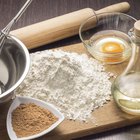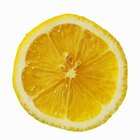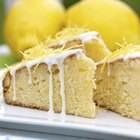
There are two schools of thought about how to correct an excess of baking powder in cake batter. One approach says to throw out the cake and start over. Another advocates adjusting the ingredients until the ratios in the batter come out the same as in the original recipe, but that's a much more difficult procedure.
Chemistry Rules Baking
The "throw it out" approach takes into account the chemical effects that baking powder has on a cake recipe. As a chemical leavener, baking powder combines baking soda with cream of tartar or other acids and an inert starch, usually cornstarch, as a dehumidifier to absorb moisture and keep the reaction from happening too quickly. This combination creates a "double-acting" leavener that works twice, first when moistened and again when heated. The first reaction creates lots of little bubbles in the batter, while the second reaction causes these bubbles to expand and lift the cake. Using too much baking powder causes a cake to rise too fast when heated, and then to fall or have a dense center when it cools. Excess baking powder also gives the cake a bitter taste. Both effects can't be corrected once a cake is baked.
Correct the Baking Formula
The "correct the ratios" approach works if you realize at the batter stage that you've added too much baking powder. The chemistry of baking comes into play again because you're trying to fix the "formula" of the cake by adjusting the amounts of ingredients. A general rule of baking says that you want about 1 teaspoon of baking powder per 1 cup of flour for leavening. This ratio is because cake batter can only hold so many bubbles before they start to break through the batter surface. Once that happens, it creates channels for lots of other bubbles to break through.
Do the Baking Math
To correct the ratios, you need to do the math. First, determine the correct ratio of baking powder to other ingredients in the batter. Let's take an extreme example. If the recipe calls for 2 cups of flour, the usual ratio of baking powder to flour would be 2 teaspoons. Suppose that you added 2 tablespoons of baking powder by mistake; that's equivalent to 6 teaspoons of baking powder, since there are 3 teaspoons in 1 tablespoon. Divide the excess amount (6 tablespoons) by the correct amount (2 teaspoons) and you get a result of 3, meaning you've added three times too much baking powder. In order to correct this ratio, you'd need to add three times the amount of flour as the original recipe, and then correct all the other ingredients such as sugar, eggs and liquid to balance the flour. It's easy to see how the "correct the ratios" method can quickly become unwieldy unless you're a professional baker or you're making several cakes at home and have room to bake them all at once.
Saving a Cake Takes Effort
In the end, saving a cake with an excess of baking powder often proves to be far more effort than it's worth because of the realities of baking chemistry (unless a large quantity is involved). It would be easier and probably tastier simply to throw out a cake with too much baking powder and make another.
Related Articles

What Causes Bubbles on Top of Cakes ...

What Happens When I Put in Too Much ...

How to Stop Cakes From Dropping

What Is a Substitute for Potassium ...

How to Replace Yeast With Baking Soda & ...
What Is the Purpose of Cream of Tartar ...

Why Is Sodium Aluminum Phosphate in ...

What Causes Cupcakes to Fall?
Does Humidity Affect Baking Times?

Does High Altitude Make a Difference ...

A Baking Mistake of Not Separating the ...

How to Make Lemon Cake Mix Ahead
Role of Xanthan Gum in Vegan Baking

How Much Melted Shortening Do I Use in ...

How to Bake a Cake: A Step-By-Step Guide

How to Bake a Cake Without Egg Whites

Roshco Silicone Bakeware Instructions

Corn Starch Vs. Baking Powder in Cooking

What Are the Causes of Large Holes in a ...

Can You Make Cupcake Mix Without Baking ...
References
Writer Bio
Cynthia B. Astle is a longtime journalist who has written on practically every topic of human interest for newspapers such as the "United Methodist Reporter," magazines including "Response," "Arts Ministry" and the "Progressive Christian" and websites such as Darkwood Brew and United Methodist Insight. She was also a food editor and restaurant reviewer for the "Clearwater Sun."
Photo Credits
Digital Vision./Photodisc/Getty Images